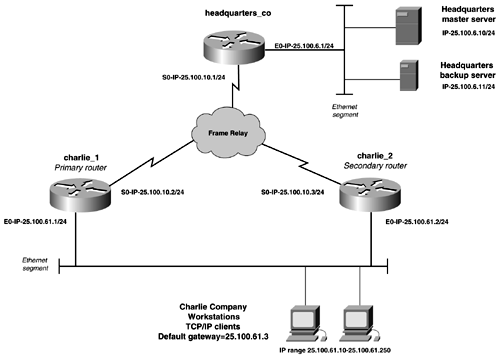Lab 33: Configuring HSRP, Tracking, and Asymetrical Routing ”Part I Practical Scenario HSRP is an effective way to provide a fault-tolerant default gateway for TCP/IP. HSRP is mostly deployed in IP environments, where there are IP hosts with static default gateways. If there is router redundancy on the network, IP clients will still forward IP packets to the default gateway address, even if that default gateway router is down. There can still be a valid path out of the network, but the clients will fail because they know only how to forward packets to the default gateway. In these cases, HSRP provides a gateway address that can be shared among many routers, thereby closing the client loophole in redundant networks. Lab Exercise The 4th Army Com Net runs a Frame Relay network between Headquarters Company and Charlie Company. The workstations at Charlie Company are IP-based and require uninterrupted access to the headquarters master and backup server. The data passed between the companies is critical; if one router fails, the other router should resume its function. Use the following parameters as your design guidelines: -
The workstations at Charlie Company are IP-based. They have static default gateways configured pointing to 10.25.61.3. Configure the network so that the workstations have uninterrupted access to headquarters_co, even upon failure of the charlie_1 or charlie_2 routers; charlie_1 should be the primary router. -
If the charlie_1 or charlie_2 serial interface fails, ensure that the router is not the primary router. Lab Objectives -
Configure the network as depicted in Figure 16-2. Use RIP V2 as the routing protocol. Configure RIP to perform asymmetrical routing with the primary router in HSRP. That is, if charlie_1 is the primary router, traffic should flow from the workstations to charlie_1, to headquarters_co, and back down through charlie_1 to the workstations. Traffic should not flow from the headquarters_co router to charlie_2 router, unless charlie_2 is the active HSRP router. Figure 16-2. 4th Army Com Net  -
Configure HSRP between charlie_1 and charlie_2. Configure the charlie_1 router to be the primary router for HSRP. -
Configure tracking on the serial interfaces. -
Optional: Improve the design of the Charlie Company network so that it operates more efficiently in an HSRP environment by using EIGRP as the routing protocol. Equipment Needed -
Four Cisco routers, three to serve as routers in the network, and one to serve as the frame switch. The frame switch will need to have three serial ports. The routers should be connected through V.35 back-to-back cables or in a similar manner. -
Two LAN segments, provided through hubs or switches. -
Optional: Two IP workstations, one to serve as a Charlie Company workstation and one to serve as the headquarters servers. Physical Layout and Prestaging -
Connect the hubs and serial cables to the routers as shown in Figure 16-2. Configure a Frame Relay switch in a multipoint configuration so that it provides PVC from headquarters_co to charlie_1 and charlie_2. The diagram does not show the frame switch or the frame switch configuration. -
Connect the two Ethernet hubs to the routers to form two LAN segments, as shown in Figure 16-2, with one segment connecting charlie_1 to charlie_2 and the other segment off of headquarters_co. -
Connect and configure two IP-based workstations, as shown in Figure 16-2, with the default gateway set to 25.100.61.3. -
Configure the headquarters_co router as shown with RIP version 2 as the routing protocol. -
Optional: Improve the design of the Charlie Company network so that it operates more efficiently in an HSRP environment by using EIGRP as the routing protocol. |
